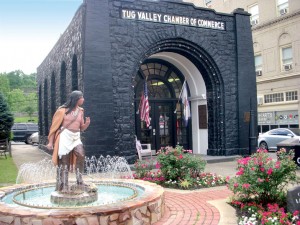By Dawn Nolan
 In the “Heart of the Billion Dollar Coal Field” lies one of the most unique tributes to the rich economic resource that supports the Southern West Virginia region and the state as a whole. In downtown Williamson sits The Coal House, the Mingo County tribute to “the other black gold.” This building, which currently houses the Tug Valley Chamber of Commerce and the Williamson Visitor Center, is constructed of 65 tons of bituminous coal from the local Winifrede seam.
In the “Heart of the Billion Dollar Coal Field” lies one of the most unique tributes to the rich economic resource that supports the Southern West Virginia region and the state as a whole. In downtown Williamson sits The Coal House, the Mingo County tribute to “the other black gold.” This building, which currently houses the Tug Valley Chamber of Commerce and the Williamson Visitor Center, is constructed of 65 tons of bituminous coal from the local Winifrede seam.
The idea for The Coal House originated with O.W. Evans, a previous manager for the Norfolk and Western Railways Fuel Department in Williamson. Evans wanted to honor the valuable mineral that has played such a central role in West Virginia’s economy, as well as its history.
In 1933, he hired H.T. Hicks, an architect from Welch, West Virginia, to erect the distinctive building and see his vision come to fruition.
The walls of The Coal House are two feet thick, which has aided in protecting the structure from outside forces such as the weather. Since its construction in 1933, The Coal House has withstood four floods. The first flood struck in 1937 and the second in 1957. The last two floods occurred in 1977 and 1984, and during these, the water reached the top of the House’s arched entrance. After the last flood in 1984, the city of Williamson built a floodwall, which helped keep the building preserved. A bi-yearly coating of weatherproof varnish also aids in the preservation of the structure. Recently, the interior was renovated as part of the City of Williamson Renovation Program.
In 1980, The Coal House was added to the National Register of Historic Places. It is an integral part of the Mingo County community, as well as West Virginia as a whole, which Natalie Young, the managing director of the chamber, says of the building. “In today’s energy-conscious world, the coal industry remains a vital component of our global economy. The Coal House symbolizes not only West Virginia’s heritage but it further testifies to the diligence of miners everywhere. The Coal House represents our past and, equally important, West Virginia’s future.”



